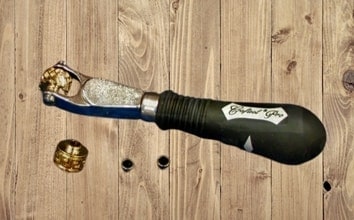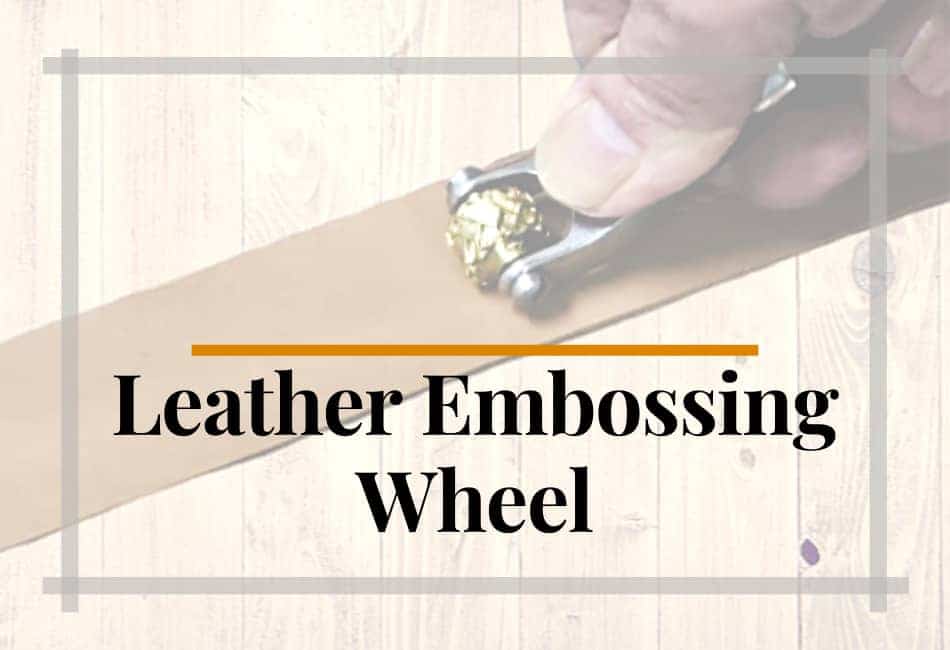The technique embossing is one of the best leather work techniques that requires the least skill set. Embossing is a truly versatile leather work technique that can be used to personalize, initialize, or brand leather goods, etc. and the fun fact is, it employs a lot of basic embossing tools and machines.
For this article, I’m going to share with you one of such basic embossing tools – The Leather Embossing Wheel, that’s going to have fantastic impact on your finished leather goods. First, let’s find out what leather embossing generally is and what it’s all about!
What is Leather Embossing?
Leather embossing is a decorative technique of causing a raised or depressed pattern or impression – usually on the natural grain side of an animal skin although some synthetic leathers can also be embossed. Embossing impressions are generally created by either using a:
- Press rolling tool/machine or
- Stamping tool/Machine
Embossing can be done essentially on every part of leather if that’s what you prefer or can be dedicated to specific potions on the leather article being made.
There are two main types of embossing you can do. These include embossing without color known as blind embossing and the embossing that includes the use of color called color imprint. There’s also a gold embossing where a gold leaf is transferred into the embossing.
With the meaning of what embossing basically is out of the way, let’s now take a look at one simple embossing tool, which is the Leather Embossing Wheel!
What’s a Leather Embossing Wheel?
The embossing wheel is a handheld tool that is made up of a handle and an interchangeable revolving decorative wheel used to create strips of embossed decorations on leather articles. It’s often used on straps and the edges of leather articles as a form of professional edge creasing or edge decoration.
The only downside to using the leather embossing wheel is how much of a pain it will be if you do a lot of projects – especially if you have arthritis in your hands. However, you can get an embossing machine so solve this issue.
There are different embossing wheels that can be mounted on the embossing tool itself. The designs on the wheels will depend on what’s made available by the manufacturers and in some cases, you would be able to mount different brands of wheels.
The leather embossing wheels are not the most sophisticated leather work tools. What it comes down to is simply adhering to simple embossing principles and factors that influence the embossing work.
I going to discussed all these factors in details, but first, let me share with you my favorite leather embossing wheel!
Best Leather Embossing Wheel on the Market

The best leather embossing wheel I like is the Tandy leather craftool Pro Embossing hand tool. It’s very easy to use and ergonomically designed to give you the softest most comfortable grip with its soft rubber handle. I love this tool for its superb durability – it’s made up of stainless steel. You can see this leather embossing wheel in action below!

With this one tool, you would be able to use over 14 different interchangeable embossing wheels which is made readily available by Tandy Leather for your convenience. You can check out some of their Embossing wheels here.
If you’re interested in getting a high quality leather embossing wheel, you can check my favorite one out from the house of Tandy Leather on Amazon!
Leather Embossing Wheel: Factors that Influence Your Imprints
There are a couple of factors that will influence your leather embossing wheel’s imprints. These include:
- The Type of Leather
- The Weight of the Leather
- The Moisture Content of the Leather
- The Pressure Used
- How Long the Stamping Pressure Takes
- The Temperature of the Embossing Tool
Let’s delve into these factors one after the other.
1. The Type of Leather
Although there are a variety of leather out there, the most popular ones you’re likely to find are the vegetable tanned leather, the chrome tanned leather, and synthetic or PU leather.
When it comes to embossing, especially with the leather embossing wheel, the vegetable tanned leather and the chrome tanned leather will generally have a much better outcome than the synthetic leather.
This is because both the chrome tanned and vegetable tanned leather are both natural leathers and like all natural leathers, they can be formed and will hold shape pretty well. Meaning whatever is impressed onto the leather will stay depressed or raised.
2. The Weight of the Leather
The weight of leather you use will to a large extent also impact the kind of result you’re going to have with your embossing wheel. The weight and thickness of leather is measured in ounce (oz) and can be measured with a leather thickness gauge.
Having said that, it also goes without saying that the leather you use shouldn’t be too thin. Unless you do not want your impressions so clear, you’re going to find a lot more success with leather weights over 1 ounce.
By using the right leather weights when working with your leather embossing wheel, the depressions from the leather embossing tool will have enough fiber layers to hold the patterns you make on them.
3. The Moisture Content of the Leather
Natural leather contains rich natural oils that makes leather supple and because of this, leather is the most perfect material for all kinds of embossing activities.
But for the best imprints from your leather embossing wheel on your leather, you would want to dampen or case the leather surface before applying the leather embossing wheel.
You will particularly want to dampen the leather because the leather embossing wheel is often used manually and dampening the leather first, helps to achieve clearer and durable prints.
Dampening, casing or moistening leather is very easy. You can do it by loading a sponge or a soft clean rag with ordinary water and the dabbing it over the surface you intend to emboss.
Just as the damp leather is about returning to its normal color, you can start embossing. The key thing is not to get the leather soaking wet.
4. The Pressure Used
A simple rule of thumb when it comes to embossing leather is – the higher the pressure, the stronger and more durable the embossed impression is going to be.
The leather embossing wheel will come with a thumb pad on the tool where you would apply maximum pressure.
There are a couple of ways you can achieve high pressure on the leather embossing wheel. But one simple way I have found is to rock the leather embossing wheel back and forth as you move along.
5. How Long the Stamping Pressure Takes
If you quickly run the leather embossing wheel over the leather, the impression won’t be as solid when compared to moving the tool a lot slower. The longer the stamping pressure you’re exerting stays on the leather, the more durable the embossing will be.
This automatically means people who happen to have arthritis in your hands are certainly not going to have a jolly good time with a leather embossing wheel especially if they want to achieve that nice solid prints.
6. The Temperature of the Embossing Tool
Ideally, the hotter the embossing tool, the better the impression is going to be. These are heated stamps or embossing tools. But with a leather embossing wheel, you’re going to be wheeling cold! But not to worry, applying enough pressure will get you a nice imprint on your leather.
How to Use a Leather Embossing Wheel
Conclusion
In this article, I shed light on a leather work tool that hasn’t seen a lot of attention from both manufacturers and leather crafters alike. But this tool, the leather embossing wheel, is fantastic and will be an invaluable addition to your arsenal of leather work tools.
It’s certainly a must-have tool. It’s very versatile and will go as far as your creativity will take it. And what helps is, it’s a fairly cheap tool that’s very simple to use and maintain. I hope you were able to get some helpful information from this article, if so, thanks for reading and see you in the next one!

